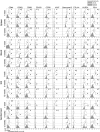Effect of preexisting immunity to adenovirus on transgene product-specific genital T cell responses on vaccination of mice with a homologous vector
- PMID: 21450997
- PMCID: PMC3107557
- DOI: 10.1093/infdis/jiq161
Effect of preexisting immunity to adenovirus on transgene product-specific genital T cell responses on vaccination of mice with a homologous vector
Abstract
We evaluated changes in global and human immunodeficiency virus (HIV)-specific genital T cells after vaccination of female mice with a replication-defective adenovirus vector of human serotype 5 (AdHu5) expressing Gag protein of HIV-1, in the presence or absence of preexisting immunity to the vaccine carrier. Our data show that preexisting immunity causes a rapid and transient decrease of genital CD4(+) T cells without increasing the expression of chemokine (C-C motif) receptor 5. Furthermore, preexposure to AdHu5 affects long-term alterations in the magnitude and quality of vaccine-induced Gag-specific CD8(+) T cell responses. AdHu5-specific antibodies interfere with the induction of transgene product-specific CD8(+) T cell responses in systemic compartments, whereas some mechanism other than antibodies also seems to affect those that home to the genital tract.
© The Author 2011. Published by Oxford University Press on behalf of the Infectious Diseases Society of America. All rights reserved.
Figures





Similar articles
-
Heterologous prime-boost regimens with a recombinant chimpanzee adenoviral vector and adjuvanted F4 protein elicit polyfunctional HIV-1-specific T-Cell responses in macaques.PLoS One. 2015 Apr 9;10(4):e0122835. doi: 10.1371/journal.pone.0122835. eCollection 2015. PLoS One. 2015. PMID: 25856308 Free PMC article.
-
A simian replication-defective adenoviral recombinant vaccine to HIV-1 gag.J Immunol. 2003 Feb 1;170(3):1416-22. doi: 10.4049/jimmunol.170.3.1416. J Immunol. 2003. PMID: 12538702
-
Recombinant adeno-associated virus vectors induce functionally impaired transgene product-specific CD8+ T cells in mice.J Clin Invest. 2007 Dec;117(12):3958-70. doi: 10.1172/JCI33138. J Clin Invest. 2007. PMID: 18008010 Free PMC article.
-
The effect of adenovirus-specific antibodies on adenoviral vector-induced, transgene product-specific T cell responses.J Leukoc Biol. 2014 Nov;96(5):821-31. doi: 10.1189/jlb.1A0813-451RR. Epub 2014 Jul 31. J Leukoc Biol. 2014. PMID: 25082150 Free PMC article.
-
Vaccination of Macaques with DNA Followed by Adenoviral Vectors Encoding Simian Immunodeficiency Virus (SIV) Gag Alone Delays Infection by Repeated Mucosal Challenge with SIV.J Virol. 2019 Oct 15;93(21):e00606-19. doi: 10.1128/JVI.00606-19. Print 2019 Nov 1. J Virol. 2019. PMID: 31413132 Free PMC article.
Cited by
-
Pre-Existing Humoral Immunity Enhances Epicutaneously-Administered Allergen Capture by Skin DC and Their Migration to Local Lymph Nodes.Front Immunol. 2021 Mar 26;12:609029. doi: 10.3389/fimmu.2021.609029. eCollection 2021. Front Immunol. 2021. PMID: 33868229 Free PMC article.
-
Adenovirus Specific Pre-Immunity Induced by Natural Route of Infection Does Not Impair Transduction by Adenoviral Vaccine Vectors in Mice.PLoS One. 2015 Dec 17;10(12):e0145260. doi: 10.1371/journal.pone.0145260. eCollection 2015. PLoS One. 2015. PMID: 26679149 Free PMC article.
-
Vaccines for the prevention against the threat of MERS-CoV.Expert Rev Vaccines. 2016 Sep;15(9):1123-34. doi: 10.1586/14760584.2016.1167603. Epub 2016 Apr 6. Expert Rev Vaccines. 2016. PMID: 26985862 Free PMC article. Review.
-
Immune recognition of gene transfer vectors: focus on adenovirus as a paradigm.Front Immunol. 2011 Sep 6;2:40. doi: 10.3389/fimmu.2011.00040. eCollection 2011. Front Immunol. 2011. PMID: 22566830 Free PMC article.
-
Middle East respiratory syndrome coronavirus vaccine based on a propagation-defective RNA replicon elicited sterilizing immunity in mice.Proc Natl Acad Sci U S A. 2021 Oct 26;118(43):e2111075118. doi: 10.1073/pnas.2111075118. Proc Natl Acad Sci U S A. 2021. PMID: 34686605 Free PMC article.
References
-
- Fitzgerald JC, Gao GP, Reyes-Sandoval A, et al. A simian replication-defective adenoviral recombinant vaccine to HIV-1 gag. J Immunol. 2003;170:1416–22. - PubMed
Publication types
MeSH terms
Substances
Grants and funding
LinkOut - more resources
Full Text Sources
Research Materials

